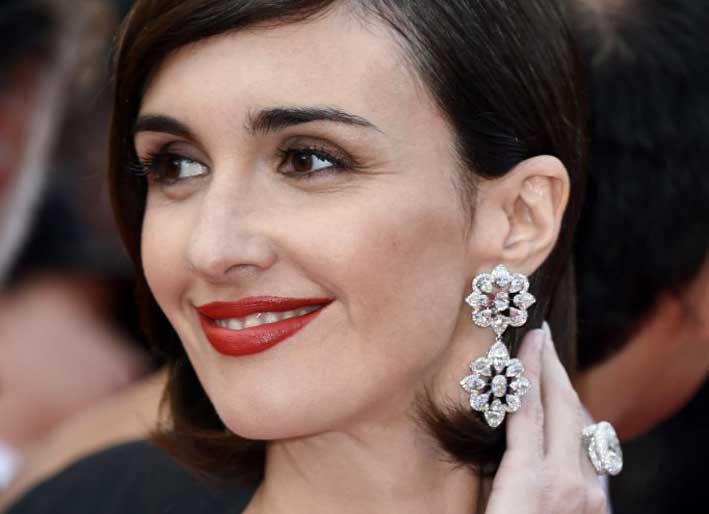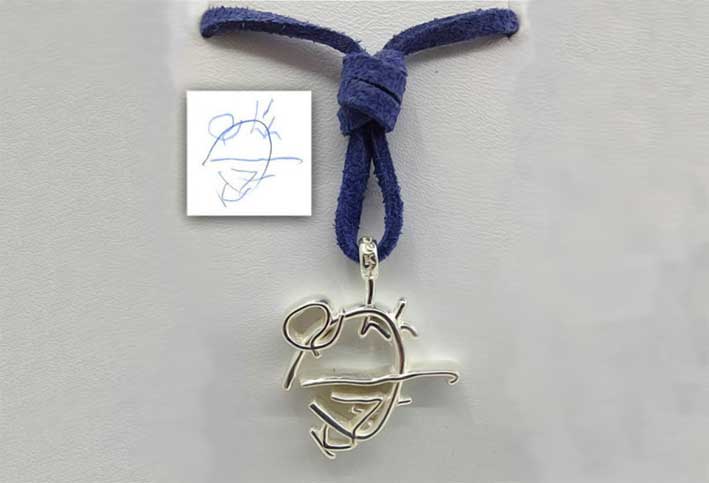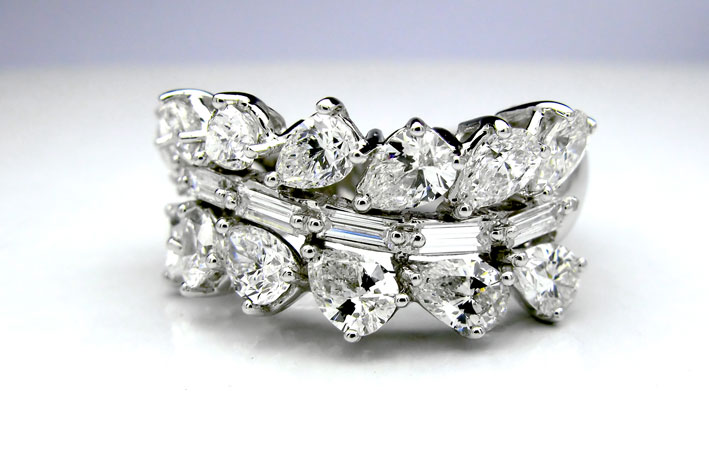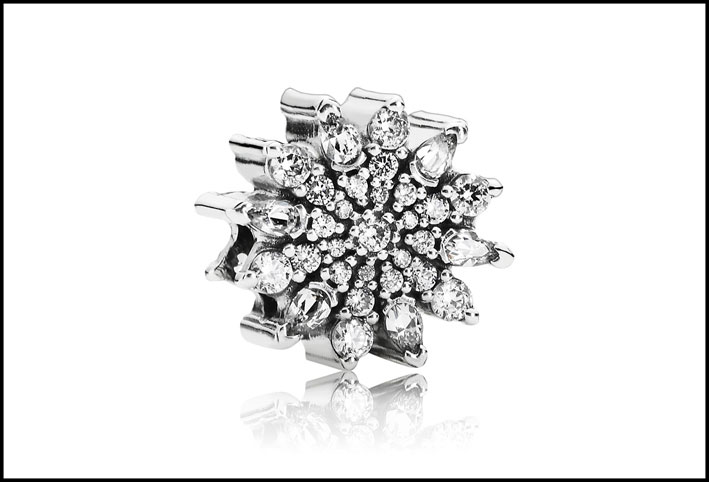
Meno gioielli rispetto al 2013, che ha fatto segnare un record. Però nel primo trimestre dell’anno la domanda globale di gioielleria è rimasta forte. Lo indicano i dati del World Gold Council. La domanda di gioielli in oro ha proseguito in effetti il percorso di crescita, con un incremento del 3 %. La domanda in termini di valore equivale, da gennaio a marzo, a 23,7 miliardi di dollari. A parte il trimestre 2013, è una cifra superiore rispetto alla media degli ultimi cinque anni: 22,7 miliardi. A incentivare gli acquisti sono stati il costo dell’oro, che è diminuito, e una ripresa generale dell’economia. Merito in buona parte dei consumatori cinesi, che hanno generato il maggiore aumento in volume della domanda di gioielli. La vicinanza del Capodanno cinese con San Valentino ha spinto il consumo: in CIna gli acquisti sono stati superiori del 10 % anno su anno. Non solo: in Indonesia e Vietnam la domanda è aumentata rispettivamente del 9% e 3 %. Al contrario, il declino maggiore si è avuto in India, con un calo del 9% della domanda. Oltre alle restrizioni alle importazioni di oro, i consumatori indiani hanno affrontato ulteriori ostacoli, come le incertezze legate alle elezioni governative del paese. Inoltre, sono state imposte restrizioni alla libera circolazione di denaro contante e altre attività, come l’oro, per la durata delle elezioni. Tutta un’altra atmosfera negli Emirati Arabi, dove è stato registrato il record dal 2008. Ma, in generale, è stata positiva la domanda in tutta la regione mediorientale. L’Egitto ha visto una crescita del 6%. Al contrario, la Turchia ha visto una discesa del 12% a causa della svalutazione della lira turca, che ha comportato un forte aumento dei prezzi dell’oro e scoraggiato gli acquirenti di gioielli.
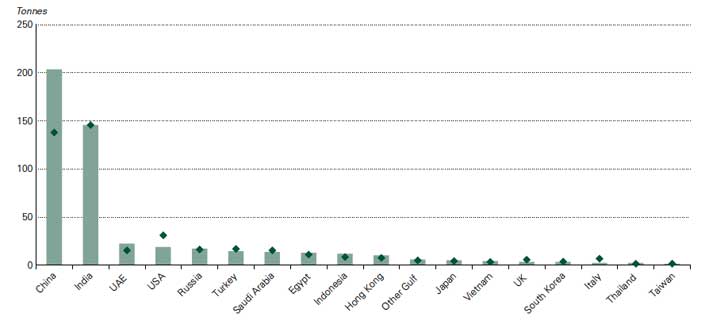
Per quanto riguarda l’Occidente, i consumatori negli Stati Uniti e nel Regno Unito hanno risposto positivamente ai prezzi più bassi dell’oro e alla ripresa economica. La domanda di gioielleria negli Usa risulta in crescita del 5% a dispetto delle bufere di neve che hanno imperversato durante l’inverno. In Russia il continuo rallentamento dell’economia, combinata con ulteriore deprezzamento del rublo e le tensioni geopolitiche, hanno portato a una riduzione nominale della domanda. Federico Graglia

Less jewelry than 2013, which has sold as record. But in the first quarter of the global demand for jewelery has remained strong. The data the World Gold Council indicate this. The demand for gold jewelry has continued in effect the path of growth, with an increase of 3% average: in terms of equivalent value, from January to March, the revenues are gone to 23.7 billion dollars. Apart the quarter 2013, is a figure higher than the average of the last five years: 22.7 billion. To encourage the purchases were the cost of gold, which has fallen, and a general economic recovery. Much of jewels were sold to Chinese consumers, which generated the largest increase in the volume of demand. The proximity of the Chinese New Year with Valentine’s Day has pushed consumption: China’s purchases were 10% higher year -on-year. Not only: in Indonesia and Vietnam, the demand has increased by 9 % and 3%. In contrast, the greater decline has occurred in India, with a 9% drop in demand. In addition to the restrictions on gold imports, Indian consumers have faced more obstacles, such as the uncertainties due to government elections in the country. In addition, restrictions have been imposed on the free movement of cash and other assets , such as gold , for the duration of the election. A totally different atmosphere in the Uae, where it was recorded the record since 2008. But, in general, was positive demand throughout the Middle East region. Egypt has seen a growth of 6%. On the contrary, Turkey has seen a drop of 12% due to the devaluation of the Turkish lira, which has resulted in a sharp rise in gold prices and discouraged buyers of jewelry.
As for the West, consumers in the United States and the United Kingdom have responded positively to lower prices of gold and the economic recovery. The demand for jewelry in the United States showed an increase of 5% in spite of the snow storms that have raged over the winter. In Russia, the ongoing economic slowdown, combined with a further depreciation of the ruble and geopolitical tensions have led to a reduction in nominal demand.
Moins de bijoux en 2013, qui était record. Mais dans le premier quart de la demande mondiale pour les bijoux est restée forte. Les données du World Gold Council indiquent cela. La demande de bijoux en or a continué en effet le chemin de la croissance, avec une augmentation de 3% en moyenne: en termes de valeur équivalente, de Janvier à Mars, les revenus sont passés à 23,7 milliards de dollars. Outre le trimestre 2013, est un chiffre supérieur à la moyenne des cinq dernières années: 22,7 milliards. Pour encourager les achats étaient le coût de l’or, qui est tombé, et une reprise économique générale. Beaucoup de bijoux ont été vendus aux consommateurs chinois, qui ont généré la plus forte augmentation dans le volume de la demande. La proximité de la nouvelle année chinoise avec Saint Valentin a poussé la consommation: les achats de la Chine étaient de 10% plus élevé d’année en année. Non seulement: en Indonésie et au Vietnam, la demande a augmenté de 9% et 3%. En revanche, la baisse plus importante a eu lieu en Inde, avec une baisse de 9% de la demande. En plus des restrictions sur les importations d’or, les consommateurs indiens ont été confrontés à plusieurs obstacles, tels que les incertitudes liées aux élections de gouvernement dans le pays. En outre, des restrictions ont été imposées à la libre circulation des liquidités et autres actifs, tels que l’or, pour la durée de l’élection. Une ambiance totalement différente dans les Émirats arabes unis, où il a été enregistré le record depuis 2008. Mais, en général, la demande était positif dans toute la région du Moyen-Orient. Egypte a connu une croissance de 6%. Au contraire, la Turquie a connu une baisse de 12% en raison de la dévaluation de la livre turque, qui a entraîné une forte hausse des prix de l’or et des acheteurs découragés de bijoux.
Quant à l’Ouest, les consommateurs aux États-Unis et le Royaume-Uni ont répondu positivement à la baisse des prix de l’or et de la reprise économique. La demande de bijoux aux États-Unis a montré une augmentation de 5% malgré les tempêtes de neige qui ont sévi durant l’hiver. En Russie, le ralentissement économique en cours, combinée à une poursuite de la dépréciation du rouble et les tensions géopolitiques ont conduit à une réduction de la demande nominale.
Weniger als 2013 Schmuck, die als Rekord verkauft. Aber im ersten Viertel des weltweiten Schmucknachfrage ist stark geblieben. Die Daten, die der World Gold Council weist darauf hin. Die Nachfrage nach Goldschmuck hat in der Tat den Wachstumspfad fort, mit einem Anstieg von 3% Durchschnitt: in Bezug auf die Gegenwert, von Januar bis März sind die Einnahmen auf 23,7 Milliarden Dollar verschwunden. Neben dem Quartal 2013, ist eine Zahl höher als der Durchschnitt der letzten fünf Jahre: 22,7 Mrd.. Um die Einkäufe zu fördern waren die Kosten von Gold, die gefallen ist, und eine allgemeine wirtschaftliche Erholung. Viel von Juwelen wurden die chinesischen Verbraucher, die die größte Zunahme der Nachfragevolumen erzeugt verkauft. Die Nähe des Chinese New Year mit Valentinstag hat sich der Verbrauch gedrückt: Chinas Käufe waren 10% höher im Vergleich zum Vorjahr. Nicht nur: in Indonesien und Vietnam, die Nachfrage ist um 9% und 3% erhöht. Im Gegensatz dazu hat die stärkeren Rückgang in Indien stattgefunden hat, mit einem 9% igen Rückgang in der Nachfrage. Neben den Beschränkungen für Goldimporte haben indische Verbraucher mehr Hindernisse, wie die Unsicherheiten wegen der staatlichen Wahlen in dem Land konfrontiert. Darüber hinaus haben Beschränkungen für die Freizügigkeit von Bargeld und andere Vermögenswerte wie Gold für die Dauer der Wahl verhängt worden. Eine ganz andere Atmosphäre in den Vereinigten Arabischen Emiraten, wo er den Rekord seit 2008. Aber im allgemeinen positiv war die Nachfrage in der gesamten Region des Nahen Ostens. Ägypten hat ein Wachstum von 6% gesehen. Im Gegenteil, hat die Türkei einen Rückgang von 12% aufgrund der Abwertung der türkischen Lira, die in einem starken Anstieg der Goldpreise und entmutigt Käufer von Schmuck geführt hat, gesehen.
Wie für den Westen, haben die Verbraucher in den Vereinigten Staaten und dem Vereinigten Königreich positiv zu niedrigeren Preisen von Gold und die wirtschaftliche Erholung reagiert. Die Nachfrage nach Schmuck in den Vereinigten Staaten zeigten eine Zunahme von 5% trotz der Schneestürme, die über den Winter gewütet haben. In Russland haben die anhaltende konjunkturelle Abschwächung, verbunden mit einer weiteren Abwertung des Rubel und die geopolitischen Spannungen zu einer Verringerung der nominalen Nachfrage führte.
Менее ювелирные изделия, чем 2013 году, которая продается как записи. Но в первом квартале мировой спрос на ювелирные изделия по-прежнему сильны. Данные Всемирного совета по золоту указать это. Спрос на золотые ювелирные изделия по-прежнему в силе путь роста, с увеличением на 3% в среднем: в терминах эквивалентной стоимости, с января по март, доходы ушли в 23,7 млрд. долларов. Помимо квартала 2013 года, представляет собой фигуру выше, чем в среднем за последние пять лет: 22,7 млрд.. Для поощрения покупки были стоимость золота, которое упало, и общее восстановление экономики. Большая часть драгоценных камней были проданы китайским потребителям, которые генерируемых наибольшее увеличение объема спроса. Близость китайского Нового года с Днем Святого Валентина подтолкнуло потребления: Китай покупки были на 10% выше в годовом исчислении. Не только: в Индонезии и Вьетнаме, спрос увеличился на 9% и 3%. В противоположность этому, тем больше снижение произошло в Индии, с падением спроса на 9%. В дополнение к ограничениям на импорт золота, индийские потребители столкнулись с большими препятствиями, например, неопределенности в связи с государственными выборов в стране. Кроме того, ограничения были наложены на свободном перемещении наличных денежных средств и других активов, таких как золото, на время выборов. Совершенно иная атмосфера в ОАЭ, где он был записан рекорд с 2008 года. Но, в общем, был положительный спрос во всем регионе Ближнего Востока. Египет видел рост в 6%. Напротив, Турция видел каплю 12% из-за девальвации турецкой лиры, что привело к резкому росту цен на золото и обескуражен покупателей ювелирных изделий в.
Что касается Запада, потребители в Соединенных Штатах и Соединенном Королевстве позитивно отреагировали на более низких цен на золото и восстановления экономики. Спрос на ювелирные изделия в США показали рост на 5%, несмотря на снежные бури, бушевавших в течение зимы. В России продолжается экономический спад в сочетании с дальнейшей девальвации рубля и геополитической напряженности привели к сокращению номинального спроса.
Menos de la joyería de 2013, que ha vendido como récord. Pero en el primer trimestre de la demanda mundial de joyas se ha mantenido fuerte. Los datos del World Gold Council indican esto. La demanda de joyas de oro se ha mantenido en vigor la senda del crecimiento, con un incremento del 3% en promedio: en términos de valor equivalente, de enero a marzo, los ingresos se han ido a 23,7 mil millones de dólares. Además el trimestre 2013, es una cifra superior a la media de los últimos cinco años: 22.7 millones de dólares. Para animar las compras fueron el precio del oro, que ha caído, y una recuperación económica general. Gran parte de las joyas fueron vendidas a los consumidores chinos, lo que generó el mayor incremento en el volumen de la demanda. La proximidad del Año Nuevo Chino con el Día de San Valentín ha impulsado el consumo: las compras de China fueron 10% más año con año. No sólo eso: en Indonesia y Vietnam, la demanda se ha incrementado en un 9% y 3%. Por el contrario, el mayor descenso se ha producido en la India, con una caída del 9% en la demanda. Además de las restricciones a las importaciones de oro, los consumidores de la India han enfrentado más obstáculos, como las incertidumbres debidas a las elecciones de gobierno en el país. Además, se han impuesto restricciones a la libre circulación de dinero en efectivo y otros activos, como el oro, por la duración de la elección. Un ambiente totalmente diferente en los Emiratos Árabes Unidos, donde se registró el récord desde 2008. Pero, en general, fue una demanda positiva en toda la región de Oriente Medio. Egipto ha visto un crecimiento de 6%. Por el contrario, Turquía se ha visto una caída de 12% debido a la devaluación de la lira turca, que se ha traducido en un fuerte aumento de los precios del oro y compradores desalentados de joyería.
En cuanto a Occidente, los consumidores en los Estados Unidos y el Reino Unido han respondido positivamente a la reducción de los precios del oro y la recuperación económica. La demanda de joyería en los Estados Unidos mostró un incremento del 5% a pesar de las tormentas de nieve que han asolado durante el invierno. En Rusia, la desaceleración económica en curso, junto con una mayor depreciación del rublo y las tensiones geopolíticas han llevado a una reducción de la demanda nominal.




